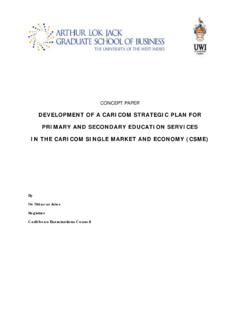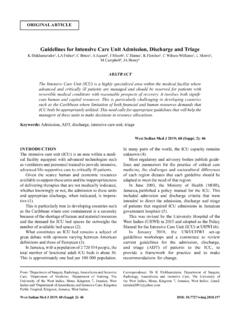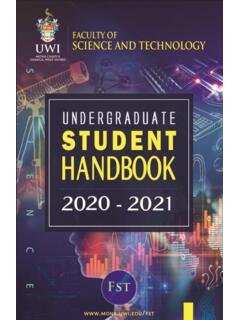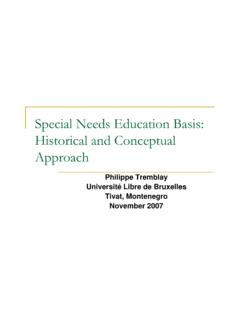Transcription of Evidence-Based Teaching Strategies for Students With EBD
1 Evidence-Based Teaching Strategies for Students With EBDJ oseph B. Ryan, Clemson UniversityCorey D. Pierce, University of Northern Colorado GreeleyPaul Mooney, Louisiana State UniversityStudents with emotional andbehavioral disorders (EBD)struggle in school, perhapsmore so than any other group ofstudents. Whereas it is commonlyrecognized that these children andadolescents have severe social skillsdeficits, which impede developmentof meaningful relationships withpeers and teachers, it is also true thatstudents with EBD evidencesignificant academic deficiencies. Onaverage, these Students perform 2grade levels behind their peers whilein elementary school (Trout,Nordness, Pierce, & Epstein, 2003).Unfortunately, this discrepancyonly worsens with age, and by thetime these Students reach highschool, they are performing grade levels below their peers,with less than one third of studentswith EBD functioning at or abovegrade level in any academic area(Coutinho, 1986; Epstein, Kinder, &Bursuck, 1989).
2 This is notsurprising, given that more than halfof Students with EBD also may meetone or more of the eligibility criteriafor a learning disability (Glassberg,Hooper, & Mattison, 1999). Thesesignificant academic deficits haveresulted in Students with EBDattaining one of the worst graduationrates ( ) of Students with anydisability ( Department ofEducation, 2006). Given that manystudents with EBD fail to masterbasic academic skills that areessential to functioning successfullywithin the community, this elevatedschool dropout rate only makes asuccessful transition to the jobmarket more challenging (Gunter &Denny, 1998). As a result, 4 yearsafter leaving high school, thispopulation experiences a postschoolunemployment rate of 52% (D Amico& Marder, 1991).Despite these dismal academicoutcomes, the majority ofinterventions conducted with thesechildren have focused primarily onbehavior modification, oftenneglecting glaring academicdeficiencies (Ryan, Reid, & Epstein,2004).
3 Recently, however, researchershave begun to place an increasedemphasis on addressing the academicdeficits of Students with EBD toincrease their engagement in school,with the hope of improvinggraduation rates (Mooney, Epstein,Reid, & Nelson, 2003). Given thedaunting challenges that teachers ofstudents with EBD face whileattempting to address these Students social and academic deficiencies, it isimportant they incorporateempirically based Teaching methodsinto their classrooms to maximizetheir Teaching , researchers at theUniversity of Nebraska s Center forAt-Risk Children s Services ( ,Epstein, Nelson, Trout, & Mooney,2005) summarized the interventionliterature targeted at improving theacademic skills and performance ofstudents with EBD served in publicschools. Conclusions from analyses ofthis small body of literature indicatedthat positive outcomes were reportedacross participants, settings, andsubject areas (Nelson, Benner, &Mooney, 2008).
4 In general, theseresearchers divided academicinterventions into three primarycategories: (a) peer-mediatedinterventions ( , cross-age tutoring,classwide peer tutoring), in which thestudent s peers were responsible forproviding instruction; (b) self-mediated interventions ( , self-monitoring, self-evaluation), in whichthe responsibility for implementingan intervention rested with thestudents themselves; and (c) teacher-mediated interventions ( , storymapping, mnemonics) wherein theteacher provided the academicinstruction to the purpose of this manuscript istwofold: (a) to highlight findings ofthese literature reviews covering overthree decades of research conductedwith Students with EBD; and (b) toprovide teachers a condensedsummary of Teaching Strategies thathave demonstrated efficacy ineducating some of the mostchallenging Students in today author acted as leadresearcher/author for one of threedifferent academic literature reviewsthat assessed the efficacy of threetypes of academic interventions ( ,peer-mediated, self-mediated, andteacher-mediated) for Students withEBD (see Mooney, Ryan, Uhing, Reid,& Epstein, 2005; Pierce, Reid, &Epstein, 2004; Ryan et al.)
5 , 2004). To beincluded in these three reviews,articles: (a) must have been publishedin a peer reviewed journal within thepast 40 years; (b) must contain anoriginal report of quasi-experimentalor experimental research; (c) mustinclude manipulation of anindependent variable; and (d) mustinclude at least one academicmeasure as a dependent participants were required tohave a verified emotional , behavioral ,or conduct disorder, disability, ordisturbance, either through theIndividuals with DisabilitiesEFFECTIVETEACHINGSTRATEGIES2 2 BEYONDBEHAVIORE ducation Act (IDEA) orclassification systems of theDiagnostic and Statistical Manual ofMental DisordersIV, or to be describedas having behavioral or emotionalproblems while being educated in aself-contained classroom for studentswith InterventionsPeer-mediated interventionsrequire Students to implement teacher-selected instruction for their peers asopposed to the more traditionalmethod of teacher-led instruction(Hoff & Robinson, 2002).
6 A widevariety of techniques fall under thepeer-mediated instruction category,including peer modeling, peermonitoring, peer network Strategies ,peer tutoring, cross-age tutoring,reverse-role tutoring, classwide peertutoring (CWPT), peer-assistedlearning Strategies (PALS), classwidestudent tutoring teams, reciprocal peertutoring, peer counseling, peerassessment, peer mentoring, andcooperative learning (Utley &Mortweet, 1997). A brief descriptionfor each of these instructionalmethodologies and the age groups( , elementary and secondary) withwhich they have demonstratedefficacy is provided inTable applying inclusion criteria,Ryan and colleagues (2004) identified14 studies from nine different specialeducation journals that involvedpeer-mediated interventionsconducted with Students with studies included 169participants, of whom 64% were boysand 16% were girls.
7 Five of thestudies (36%) were conducted withparticipants between the ages of 6and 11 years (n544), and theremaining 9 studies (64%) involvedadolescents older than 12 years of age(n5125).Overall, peer-mediatedinterventions demonstrated stronglypositive findings relative toimproving academic performance. Asreported by effect size (ES), whichrepresents the strength of anTable 1 TYPES OFPEER-MEDIATEDINTERVENTIONSI nterventionDescriptionEvidence BaseElementarySecondaryClasswide peer tutoring(CWPT)Entire class simultaneously participates in tutoring dyads. Duringeach tutoring session, Students can participate as both tutor andtutee, or they can participate as either the tutor or learningSmall teams composed of Students with different levels of ability usea variety of learning activities to improve the team s understandingof a subject. Each member of a team is responsible not only forlearning what is taught but also for helping teammates tutoringOlder Students are matched with younger Students to deliverinstruction.
8 Tutors are typically at least 2 years older than the do not need to be large differences in skill levels between thetutor and tutoringStudents who need remedial support are paired with select tutors(perhaps highly skilled peers, peers also in need of remedial work, orcross-age tutors). Each member of the dyad may receive and providetutoring in the same content area, or tutors can provide instruction ina content area in which they are highly learningstrategiesA version of CWPT in which teachers identify children who requirehelp on specific skills and the most appropriate children to helpthem learn those skills. Pairs are changed regularly, and over time,as Students work on a variety of skills, all Students have theopportunity to be coaches and players. XPeer assessmentPeers are used to assess the products or outcomes of learning ofother Students of similar modelingStudents acting as peer models receive instruction in desiredbehaviors, then engage in these behaviors in front of studentsdeficient in these areas.
9 The teacher draws the student s attention tothe peer model and identifies the desired behaviors the studentshould reinforcementPeers provide reinforcement for appropriate responses within thenatural environment. The purpose is to reinforce appropriatebehaviors of Students with disabilities by their or outcome through anumerical rating in which an ES of 0 is considered small, ismedium, and greater than is large(Cohen, 1988), the results were quiteremarkable. The authors reported thatthe overall ES of peer-mediatedinterventions was Whenevaluating the effectiveness of peer-mediated interventions acrossacademic subject areas, the findingswere equally impressive, with largegains seen in math ( ), history( ), and reading ( ). In addition,Ryan et al. (2004) found that studentsbenefited from this form of instructionregardless of the role they held, be it astutor ( ), tutee ( ), or whensharing both roles ( ).
10 Similarpositive findings were reported evenacross age groups, be they inelementary grades or high , and critical to practitioners,both the Students and teachers enjoyedusing peer-mediated interventions,reporting high levels of consumersatisfaction. Students made positivecomments, claiming that tutoringhelped them understand their peers needs ( , empathy), as well as howto ignore inappropriate specific peer-mediatedinterventions that demonstrated highlevels of efficacy were cross-age andsame-age peer tutoring. A successfulexample of cross-age peer tutoringwas conducted by Cochran, Feng,Cartledge, and Hamilton (1993). Inthis study a special education teacherhad half her class of fifth-gradeAfrican American boys acting astutors for Teaching sight words toyounger Students . The tutees werelow-performing second-gradeAfrican American boys also identifiedwith EBD.
















